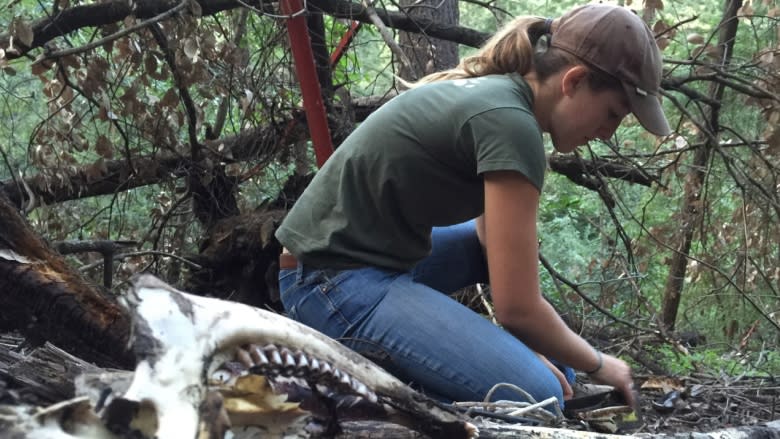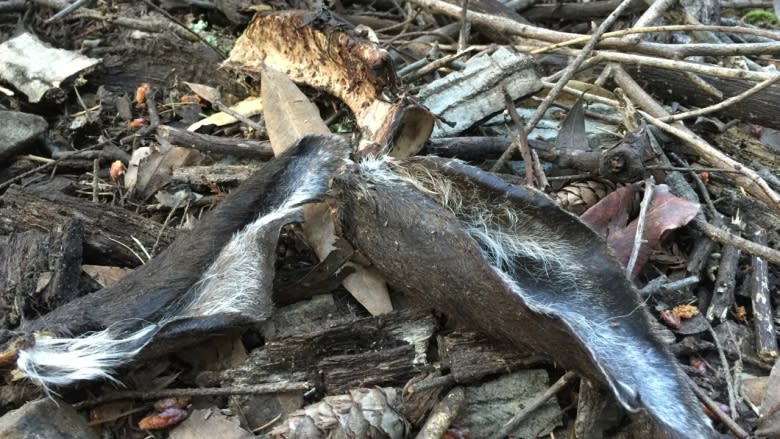Southern California mountain lions' gene pool is running dry
Trekking through the dense bush in California's Santa Cruz mountains, field biologist Justine Smith is full of helpful tips.
Like this one: if you're searching for a hidden carcass and can't smell it, just listen.
"You can hear the flies around the carcass," Smith explains.
Smith, a doctoral student and researcher at the University of California, Santa Cruz, is trying to figure out what impact people — and the nearby roads — are having on the mountain lions. Humans may be setting the protected species on a slow, quiet path to extinction.
Smith is tracking radio-collared lions, and wherever she finds a kill she sets up a camera to record them feeding. On this morning, Smith is doing the rounds of the kill sites, retrieving her cameras and her footage.
"We're getting pretty close to our first kill," Smith says, consulting her GPS. Two minutes later we find it, hidden under a bush: the half-eaten remains of a deer.
"I think you're standing right above a bone there." she says, pointing at my feet.
One of the first things I learn about mountain lions is that, for some reason, they just don't like ears.
"They often rip the ears off," Smith says. "I don't know why that is. Maybe to get to the head meat."
Females not eating enough
Smith opens the first camera and plays the footage on her laptop. The infrared, motion-activated camera shows a small mountain lion the size of a large house cat walking up to the kill. Biologists have named him 49-M.
"He's about eight months old and he's a kitten of 19-F, who made this kill," Smith says.
Her research has shown that because their kills are so close to people and cars, the females can't finish their meals and aren't eating as much as they should. It's an important finding but it's not the mountain lions' biggest problem.
Smith shows me a map full of red zigzagging lines.
"You see him pushing the boundaries of his habitat ... So far we've never seen a puma successfully disperse out of our study area.
She's been tracking a male that's trying to escape his territory in order to meet and breed with females to which he's not related. But he can't because he's trapped by traffic. Every time he gets close to the highway bordering his territory he has to turn back. Smith points out his trajectory.
"It'll be really interesting to see if he tries to make it," Smith says.
Smith says even though the total number of mountain lions (between 4,000 and 6,000) isn't cause for concern, each individual pocket of lions is quite small and unable to mix. Without any new blood, Smith says, the mountain lion gene pool is drying up.
"To have this big barrier of the freeway bisecting our small mountain range even smaller probably has pretty dramatic effects on the gene flow between these two halves of the mountains," Smith says. "It means the possibility of inbreeding is pretty high. And I wouldn't be surprised if we did see genetic effects in the near future. When you don't have enough animals in a population, you get inbreeding which causes sort of the bad genes in a population to be really prevalent and can hurt the whole health of the population."
The offspring resulting from inbreeding tend to have health problems and trouble breeding. That's what happened to a subspecies of the mountain lion: the Florida panther (panthers, pumas and mountain lions are the same animal).
"The Florida panthers had significant inbreeding effects to the point that they had to bring in pumas from Texas to supplement the population's genetic diversity," Smith says.
Hollywood stars
Further south of Santa Cruz, a few mountain lions have become famous — Hollywood stars — for crossing California's massive highways, like the cat known as P-22. The animal crossed two major freeways and was photographed with the Hollywood sign behind him. He now has his own Twitter handle and Facebook page.
However P-22 is the exception; most of the few lions that cross highways end up being removed by animal control, shot, or most commonly, hit by cars. It's a conundrum, Smith explains, because she wants the mountain lions to cross the roads in order to foster genetic diversity but she doesn't want them to get killed.
"Luckily," Smith says, "hopefully soon we won't have to make that compromise." Smith points at the nearby highway. A local ecological trust has bought up land on either side of it.
"Both sides of this main crossing area, we see a lot of pumas hit by cars," Smith says. "And they're also putting in an underpass, so hopefully within a few years animals will be able to cross under Highway 17 at this important spot and encourage connectivity between the two parts of our study area."
Other land trusts in Southern California are doing the same thing. Smith says what's happening here is an important lesson for Canadian conservationists, because this problem is happening wherever large animals and highways intersect.
'Fragmented habitat'
"In this place where it's already occurred, I think we can hopefully provide some advice for how to better plan new developments," Smith says. "Understanding these fear responses and how it changes the biology and interactions among wildlife species is going to be necessary going forward in trying to conserve species in fragmented habitat."
Smith takes me to our last kill of the day. Incredibly, it's in someone's backyard, about 20 metres from their house. Traffic roars down a major road not far away.
"They're very good at being secretive about their kills," Smith says. "Folks very often don't know that a lion was on their property."
And there they are: less than a metre away from the carcass lies another pair of discarded deer ears.
"It's funny," Smith says, picking them up and examining them. "It's almost every time."
On the tailgate of her truck, Smith opens up the camera and fast-forwards through the footage. There's another kitten, walking up to the camera and looking into the lens.
"Hah!" Smith smiles. "Giving us an up-close and personal shot. Oh, wow!"
It's great footage. But what Smith really hopes to capture is something far more rare: a newcomer, a cat no one around here has ever seen before.




